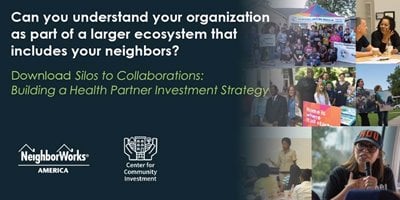The majority of NeighborWorks network organizations have initiatives that address the interconnection between affordable homes and healthier living. Some of these projects include food pantries, exercise classes and community gardens. Programs like these are important, but there are also opportunities to have an even greater impact on a community's health by partnering with health industry organizations, according to Romi Hall, NeighborWorks America's director of healthy homes and communities.
 Health industry organizations and community development leaders share similar goals of building stronger, healthier communities, Hall says. "And if we worked on them together, we could actually improve community conditions and generate better health outcomes."
Health industry organizations and community development leaders share similar goals of building stronger, healthier communities, Hall says. "And if we worked on them together, we could actually improve community conditions and generate better health outcomes."
Hall led the Health Partner Investment Learning Lab, a partnership with the Center for Community Investment (CCI) that was funded by Capital One. The Learning Lab's mission was to understand how housing and health organizations could collaborate most effectively. It led to the development of a new community toolkit that helps community development organizations think strategically about incorporating health industry partnerships into their programmatic planning.
That includes approaching potential health industry partners for more than funding support. "You really need to shift from this financial focus to a larger focus, understanding their priorities and your priorities, but most importantly, understanding the community priorities," Hall says. "How do those fit into the mission alignment of creating better health outcomes for communities in the long term?"
The toolkit "From Silos to Collaborations: Building a Health Partner Investment Strategy" is designed to address longer-term systemic solutions by ensuring community development organizations have the foundation to start such programs.
 It will help "organizations shift mental models, organize internally and build relationships to actively lay the groundwork for development that is solidly grounded in community aspirations and needs," says Omar Tinajero Carrillo, director of partnerships and initiatives at CCI. "We look forward to seeing more community-oriented developers partner with health systems to access and deploy resources and investments to advance community priorities. We know that housing is health."
It will help "organizations shift mental models, organize internally and build relationships to actively lay the groundwork for development that is solidly grounded in community aspirations and needs," says Omar Tinajero Carrillo, director of partnerships and initiatives at CCI. "We look forward to seeing more community-oriented developers partner with health systems to access and deploy resources and investments to advance community priorities. We know that housing is health."
Featured in the toolkit is a readiness assessment, developed with Success Measures at NeighborWorks. It walks a community organization through the recommended steps to ensure a successful partnership strategy, including a collaborative organizational culture with a transformation orientation and the capacity to grow.
The toolkit also helps organizations understand how a health industry leader may approach a potential partnership, including "the role of investment in facilitating health outcomes outside of the doctor's office," Hall says. "Most health is informed in the community, in the places where you live, work and play." That reality became especially clear throughout the COVID-19 pandemic when health was community-focused and organizations sought to solve for social determinants of health.
Michelle de la Uz is executive director of Fifth Avenue Committee (FAC), a NeighborWorks network organization in Brooklyn, New York. She was part of the cohort that went through the Health Partner Investment Learning Lab that led to the toolkit. "We were exposed to the fantastic innovative partnerships that exist in other parts of the country – and hopefully in New York soon."
One lesson FAC learned – and that's also shared in the toolkit – was how to find the right allies within health partner organizations. "You need to have a whole bunch of the right people at the table in order to get traction in the conversation," de la Uz says. "I think it helped us understand that maybe the people that we were most accustomed to working with are not always the ones in the decision-making seats for the kinds of transformative investments that we're talking about."
Since participating in the Learning Lab, FAC has had months of discussions with NYU Langone Health. "We're starting to see signs that they understand the potential of the scale of partnership that we're talking about," de la Uz shares.
Health organization leaders may have different motivations for investments, "but uniquely across the board, they really need to have impact around outcomes, and they really need to understand community priorities differently than they understand them in a hospital," Hall says. That strategic thinking is similar to how NeighborWorks network organizations can think about their own missions, she adds. "We need to build more housing for people, but who are those people that we're trying to build for, and what is it that they need?"
Download "From Silos to Collaborations: Building a Health Partner Investment Strategy" to kick off conversations and start building partnerships with health industry leaders.
10/18/2022

